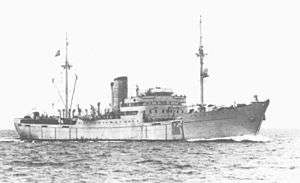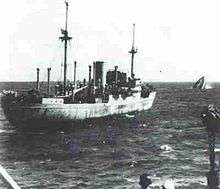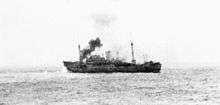German auxiliary cruiser Stier
 The Stier under way. | |
| History | |
|---|---|
| Class and type: | Merchant vessel |
| Owner: | Atlas Levant Line |
| Builder: | Germaniawerft |
| Launched: | 1936 |
| Christened: | Cairo |
| Fate: | Requisitioned by Kriegsmarine, 1939 |
| Name: | Stier |
| Namesake: | Taurus |
| Operator: | Kriegsmarine |
| Yard number: | 6 |
| Recommissioned: | 10 May 1942 |
| Renamed: | Stier, 1939 |
| Reclassified: | Auxiliary cruiser, 1939 |
| Nickname(s): |
|
| Fate: | sunk South Atlantic, 27 September 1942 |
| General characteristics | |
| Tonnage: | 4,778 GRT |
| Displacement: | 11,000 tons |
| Length: | 134 m (440 ft) |
| Beam: | 17.3 m (57 ft) |
| Draught: | 7.2 m (24 ft) |
| Propulsion: | 1 × 7-cylinder diesel engine, 3,750 hp (2,796 kW) |
| Speed: | 14 knots (26 km/h; 16 mph) |
| Range: | 50,000 nmi (93,000 km; 58,000 mi) at 12 knots (22 km/h; 14 mph) |
| Endurance: | 173 days |
| Complement: | 324 |
| Armament: |
|
| Aircraft carried: | 2 × Arado Ar 231 floatplanes |
Stier (HSK 6) was an auxiliary cruiser of Nazi Germany's Kriegsmarine during World War II. Her Kriegsmarine designation was Schiff 23, to the Royal Navy she was Raider J.
The name Stier means "bull", and represents the Taurus constellation in the German language. She was the last German raider to break out into the Atlantic in World War II.
Early history
Built by Germaniawerft in 1936 as the freighter Cairo, she was operated by the Atlas Levant Line (ALL) until being requisitioned for Kriegsmarine services in November 1939. After merchant warfare operations in the Baltic Sea, she was converted into a mine layer and was planned to be used during Operation Sea Lion. After this operation was canceled, the now renamed Stier was modified into an auxiliary cruiser in April 1941, first at the Wilton shipyard Rotterdam and later at Oderwerke, Stettin, and Kriegsmarinewerft, in Gotenhafen (Gdynia).
Raiding voyage
On 10 May 1942 she left Germany for operations in the Atlantic. Moving by stages down the English Channel, and after an engagement with British coastal forces on the 13th which saw the loss of two torpedo boats (German) and one MTB (British), Stier reached Royan in occupied France on the 19th. From there she departed under the command of Fregattenkapitän (later Kapitän zur See) Horst Gerlach for operations in the South Atlantic. After a cruise of 4½ months, in which she engaged and sank three ships, on 27 September 1942 the ship was sunk during a battle with an American cargo ship, the SS Stephen Hopkins, which was also lost.

During her operation the Stier sank four ships, totalling 29,409 tons (GRT).
Final engagement
On 27 September 1942 Stier encountered the Liberty ship Stephen Hopkins en route from Cape Town to Paramaribo.
Closing in foggy conditions the two ships sighted each other around 08:52 at a distance of 4,000 yards. Gerlach sent his men to action stations; the master of the Stephen Hopkins was suspicious of the unidentified vessel and did the same. The Stephen Hopkins had a small defensive armament (1 × 4 inch gun astern, 2 x 37mm guns of an unknown model forward and 6 x machine guns), but when firing commenced, around 08:55, she put up a spirited defence. She scored several hits on Stier, damaging her engines and steering gear. However, overwhelmed by fire from Stier, the Hopkins drifted away; by 10 am she had sunk. Forty-two of her crew were killed in the action, and three more died later; the fifteen survivors finally reached Brazil 31 days later. Stephen Hopkin's commander, Captain Paul Buck, was posthumously awarded the Merchant Marine Distinguished Service Medal for his actions. So was US Merchant Marine Academy cadet Edwin Joseph O'Hara, who single-handedly fired the last shots from the ship's 4-inch gun.

Meanwhile, Stier had been fatally damaged; unable to make headway, and not responding to the helm, Gerlach made the decision to abandon ship. Stier exploded and sank at 11:40.[1] All but two of her crew survived and were rescued by the German supply ship Tannenfels, which was accompanying Stier at the time of the action and returned to France on the blockade runner.
Raiding career
| Date | Ship | Nationality | Tonnage | Fate |
|---|---|---|---|---|
| 4 June 1942 | SS Gemstone | British | 4,986 | Sunk |
| 6 June 1942 | SS Stanvac Calcutta | Panamanian | 10,170 | Sunk in combat |
| 9 August 1942 | SS Dalhousie | British | 7,250 | Sunk |
| 27 September 1942 | SS Stephen Hopkins | American | 7,181 | Sunk in combat |
References
- ↑ Turner, L.C.F. (1961). War in the Southern Oceans: 1935-45. Oxford University Press, Cape Town. p. 148.
- Paul Schmalenbach (1977). German Raiders 1895–1945. ISBN 0-85059-351-4.
- August Karl Muggenthaler (1977). German Raiders of World War II. ISBN 0-7091-6683-4.
- Stephen Roskill (1956). The War at Sea 1939–1945 Volume II.
Coordinates: 28°8′0″S 11°59′0″W / 28.13333°S 11.98333°W